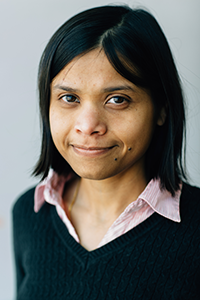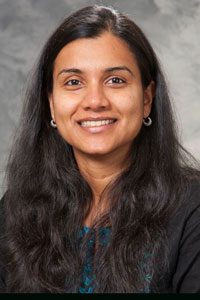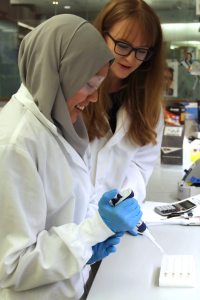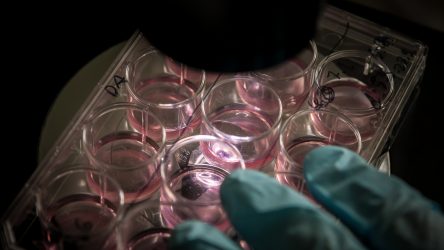Stem cells are one of the most important tools available in modern biomedical research and are critical for developing regenerative therapies. Induced pluripotent stem (iPS) cells — cells that were once differentiated and only capable of serving particular functions but have been reprogrammed back into stem cells — can reduce the need for embryonic stem cells and create new and promising possibilities in precision medicine.
Those possibilities, however, are limited by the inefficiency of current methods of inducing pluripotency: in a batch of 100 cells slated for reprogramming, only five or so complete the transition. A team of researchers at the University of Wisconsin–Madison’s Wisconsin Institute for Discovery and School of Medicine and Public Health are combining laboratory and computational methods to better understand how differentiated cells become pluripotent cells and how they might make the process faster and more efficient.


Rupa Sridharan, assistant professor of cell and regenerative biology, studies the epigenetics of cell fate. By examining and manipulating which of a cell’s genes are expressed, she seeks to understand how the cell transitions from one type to another. “We start off with cells that are completely differentiated, meaning they can only do one thing,” explains Sridharan. “For example, a skin cell can only be a barrier, a lung cell can only help us breathe, whereas a pluripotent cell has the potential to become any of those cells.”
In order for a cell to be successfully reprogrammed, genes that code for the specific functions of a differentiated cell must be suppressed, or “turned off”, and the ability to become any type of cell must be activated. Sridharan’s collaborator associate professor of biostatistics and medical informatics Sushmita Roy is an expert in using statistical computational methods to identify gene regulatory networks. Roy develops algorithms and tools to predict and characterize the regulatory relationships between genes and how they are expressed.
Traditionally, researchers have believed that gene regulatory events must occur sequentially during reprogramming: turn off differentiated function, then turn on pluripotency. But application of new methods suggests something else.

Until recently, scientists have measured average gene expression across populations of cells at various time points, getting average expression profiles for the whole group. This method leaves out important information about what individual cells are doing and can obfuscate divergent subpopulations and more rare expression profiles. To pinpoint what is happening in individual cells, Sridharan’s group has implemented single-cell analysis, a technique known as scRNA-seq, in which each cell is measured separately at the same time points. The results were unexpected. Zafirah Zaidan, a graduate student in the Sridharan lab, explains, “the cells that undergo reprogramming do not have to do so in a stepwise manner.” Individual cells can activate properties of pluripotency without shutting down their differentiated features.
Sridharan believes such cells are good candidates for completing the transition to pluripotency and that focusing on such cells may be a path to greater efficiency. Her lab has already had success using pharmacological interventions that modulate signaling and epigenetic components to overcome barriers to efficient reprogramming: a new cocktail of small molecules has jump-started the cell cycle in iPS cells, a critical advance that has increased the success rate to around 40% and shortened the time scale of induced pluripotency. Sridharan believes that adding molecules that down-regulate differentiation features could further improve efficiency. Profiling the epigenome at the single-cell level will allow her to determine which genes are poised to change expression before that expression even begins.
The work, published today in Cell Reports, relies on Sridharan’s ongoing collaboration with Roy, who is also a faculty member at the Wisconsin Institute for Discovery. Roy and her lab developed the algorithms that made sense of the data from the single-cell analyses. “scRNA-seq is revolutionizing biology and is opening up a lot of opportunities to gain a high-resolution view of gene regulatory networks,” says Roy. That insight allowed the research team to spot differences emerging between individual cells, which Roy says is only the beginning: “there is a lot of room to develop the right type of computational tools to fully unlock the potential of these single-cell RNA-seq datasets.” Those tools can then be applied to any biological problem with similar inherent heterogeneity, for example, understanding how functional cells become tumorous.
The algorithms also gave insight into how the regulatory networks change as the chemical cocktail changes. Identifying what small molecules to add next may be the key to unlocking further gains in efficiency. By combining laboratory and computational tools, Sridharan asks, “can we rationally come up with what that molecule should be?” The answer might shape the future of regenerative therapies and precision medicine.
— Nolan Lendved
This work was supported by the NIH R01GM113033 and Shaw Scientist Award to Rupa Sridharan and NIH-NIGMS R01GM117339 to Sushmita Roy. Khoa Tran was supported by the Advanced Opportunity Fellowship from UW-Madison and NSF- GRFP-DGE-1256259, Stefan Pietrzak by the NHGRI-5T32HG002760, Nur Zafirah Zaidan by the SCRMC fellowship from UW-Madison and American Heart Association-18PRE34080337, Sunnie Grace McCalla by the Data Sciences Initiative of UW-Madison and NIGMS-T32GM007133 and Amber Zhou by the NIGMS-T32GM008688.


You must be logged in to post a comment.